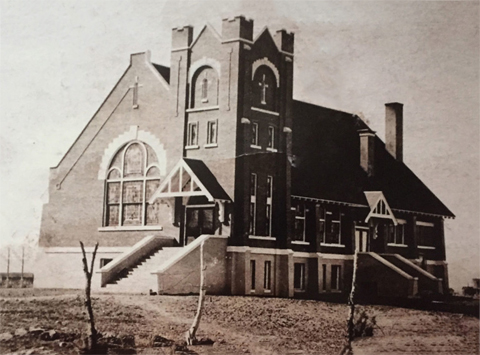1887-1918
If Roy could have had his choice of anything in the world to be, he would have been a gypsy. He just wasn’t like the rest of the Daltons, except maybe Grandpa Matthew, who was a traveler too. Roy was smaller than the other boys and had an easy-going way about him. He, like the other boys, liked horses, but he liked his hooked up to a wagon. From the time he was little, he liked to collect things; anything to add to his collection. Roy had been 14 when they moved to the Ranch, and he liked it there, but didn’t like to work. He guessed the very hardest thing in his life had been when Matt had died. He loved Matt, and Liza seemed like his sister. He was glad when she stayed on the ranch after Matt’s death. It was good to watch little Elizabeth grow up and become the pet of the whole family.
After his father died on September 3, 1913, Gene and Roy rented the farm from their mother, but they didn’t get along at all. Roy stayed until after the harvest, and then struck out on his own.
Roy decided the only way he would ever have a farm of his own was to homestead one. His brother George had taken up a homestead out west of Malad, on the Sandridge, west of Will Enans’ place by the Big Spring, and he could stake his claim out west of George’s right next to the mountains. It was peaceful out there, there were fish in the river, not too far away, and deer in the hills, so they could have meat, and once the land was broken, it would grow good crops. The only catch was that Roy didn’t want to break the land up. He fenced the land and hauled logs to build a house, then lost interest, or perhaps lack of money, for there was no water on the land.
About this time, Roy had grown up in years and in experience, and his sister-in-law Eliza didn’t seem so much older than him. Actually she was only two years older, and as time passed, Roy decided his feelings for Eliza and Elizabeth were more than just friendship, and on June 14, 1910 they were married by William H. Richards.
Leroy was able to get a job hauling milk from farmers to the Creamery on Samaria Lane, in Malad, and the family lived in an apartment above the Creamery. Wanting a home of their own, they found a vacant house they could have, so they cut it in two, and had it moved to a lot, and planned to put it back together the next spring. Come spring, they found some sheepherders had been cold that winter, and had burned their cut-in-two house for firewood. They continued to live above the creamery, and it was there that Eliza gave birth to twin daughters and named them Lola and Lona on April 9, 1911. It was hard work for Leroy to support his family, and he took whatever jobs he could find around the valley, working for farmers and collecting junk for resale. On December 11, 1914 Roy and Liza were the proud parents of a son whom they named Albert LeRoy or Lenor Dalton.
Rumors of a World War were everywhere, but as the winter changed to spring that year of 1917, Roy was concerned about Liza’s health. It was thought by the doctor that Liza had a tumor, or a series of abscesses. Finally on Monday, March 6, Roy’s mother took Eliza to the hospital in Ogden, and that evening the abscess broke ( there is a possibility that she had a tubal pregnancy, which ruptured and caused peritonitis). Whatever the cause, Eliza died the next morning and 6 a.m. a very heart-broken Mary Jane brought her back to Malad, and she was buried there on March 10, 1917.
Grandmother Mary Jane became mother to the four children of Matt and Roy. Roy, hearing of work in Nampa Idaho, moved there, leaving the children with his mother. Since the 1915 sinking of the Lusitania Ship, the American people had been recurrently shocked by U-boat attacks on passenger vessels. President Woodrow Wilson threatened to break diplomatic relations with Germany if the attacks continued. They stopped for a few months, but recurred. Condemning German Submarine policy as “warfare against mankind’, President Wilson asked Congress for a Declaration of War on April 2, 1917. Four days later the United States declared war against Germany.
Matt and Eliza’s daughter, Elizabeth, had been working on November 7, 1918 and had just arrived home from her job at the Hendricks Cafe, when her Uncle Geoge came to the house with the sad news that her step-father, Roy, had died of the Flu. One of the first of many who would die from the disease before the winter was over. Grandmother Dalton and uncle Ev went to Nampa and brought the body home. This was so sad for all of them and made more so by the fact that all public places were closed and public meetings had been banned, so only an outdoor funeral could be held that cold November 9th, and Roy was buried in the cemetery at Malad beside Liza and Matt. (picture of LeRoy Dalton)
